The Impending Demise of the Terrestrial Planets
Our solar system is made up a Sun, eight planets, as well as rocks, dust, gas, dark matter and other stuff probably haven’t crossed our consciousness yet. In my previous post where I wrote about the Andromeda galaxy, how big it is in size in comparison to our host galaxy - The Milky Way. Although, when I was comparing both galaxies, I made our solar system seem quite a little, well, in reality, our solar system is really enormous. So far, only one spacecraft known as the Voyager-1 has ever flown from our planet - the Earth, all the way to the edge of the solar system. And it took the Voyager-1 35 years to complete this task.
In this post we are going to take a little trip, exploring the Rocky planets of our solar system, which are the first four planets after the Sun. These planets are Mercury, Venus, Earth and Mars when arranged in order of succession. They all share a lot in common, from their composition and size, and according to astronomical forecasting, they all have a similar fate, their damnation
About the Terrestrial Planets
Also known as rocky planets or telluric planets, they are planets which basically comprises metals and silicate rocks in their composition. The origin of the name “terrestrial planet” has its origin from the Latin word “Earth” (Terra and Tellus) which implies that these planets share a structural resemblance with the Earth, or are basically “Earth-like resemblance”. The difference between the terrestrial planets and their giant counterparts (which I will be writing about in my next post) is that they possess a solid surface.
Structural Morphology
Rocky planets in the Milky Way galaxy all have the same fundamental structure some of which includes having a core made of metals, which mostly is iron, surrounded by a silicate mantle. The Moon, which is the Earth’s only permanent satellite is made up a metallic core similar to that of the terrestrial planets, the only difference is that it has a much smaller core. Europa and Io which are satellites that orbit the gas giant Jupiter, also, structurally resemble the terrestrial planets in terms of possessing a metallic core.
Rocky planets morphologically can be said to possess craters, canyons, volcanoes and mountain, amongst other similar structures on its surface. But this is largely dependent on the existence of tectonic and water activities.
Telluric planets also possess secondary atmospheres whose origin are tied to comet impacts as well as volcanic activities. In comparison to the giant planets which are quite different, as they got their atmospheres straight from the solar nebula.
MEET THE TERRESTRIAL PLANETS
As mentioned earlier, the four terrestrial planets in the solar system are Mercury, Venus, Earth and Mars. Among which only the Earth is said to possess an active hydrosphere. It is believed that during the formation of the solar system that we have come to know, there probably were several other terrestrial planetesimals, but due to some unknown factors, most of them merge with the existing four rocky planets or were simply ejected out of the picture.
Pluto, Ceres, Eris and other small solar body systems that are generally referred to as dwarf planets but have similar composition as the terrestrial planets due to the fact that they possess a solid surface. Although, they are mainly composed of icy materials on an average level (Pluto, Ceres, Eris have densities of 1.87, 2.17, and 2.52 g.cm<sup-3 respectively).
Mercury
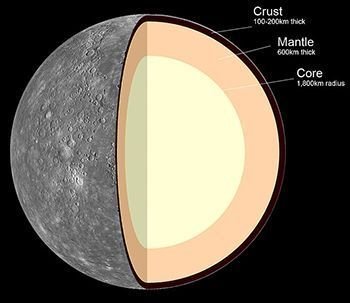
Internal Structure of Mercury by Jcpag2012 with Creative Commons Attribution-share Alike 4.0 International License
Named after the fast-footed Roman messenger god, due to the speed with which it orbits the Sun. Mercury which takes merely 88 earth days to perform a complete orbit around the Sun, making it the fastest planet in the solar system to be able to do so; moving at a speed of 180,000km/h. Being the first planet after Sun, one will expect Mercury to be the hottest planet in the solar system, which is absolutely wrong.
Mercury is an incredibly hot planet which is as a result of its close proximity to the Sun, during the day, surface temperatures can get as high as 450oC, but because the planet lacks an atmosphere to trap this heat energy, at night, temperatures can drop to -170oC. Also, due to the lack of an atmosphere, the planet has been scarred by the impact of craters which came as a result of comets and meteorites.
Being the smallest planet in the solar system, only one larger than Pluto, it is the second densest after Earth. It possesses an iron core with a radius of 1,100 miles, which makes up an estimated 75% of Mercury's diameter.
Venus
Often referred to as Earth’s sibling planet because of the striking similarities (in size, mass, composition and density) both planets share, Venus, who got its name after the Roman goddess of love, sex, beauty and fertility is the only planet named after a female, probably because of its luminosity at the time of discovery. Currently, much of the allure that accompanied the name - Venus has dissipated as the once beautiful planet, is now plagued with a hellish atmosphere with temperatures hot enough to melt tin, lead and zinc.
Known as the planet that possesses the highest temperature in the solar system, temperatures on Venus can get as high as 465oC. The contents of its atmosphere are made up primarily of carbon dioxide, and a cloud that comprises a sulphuric acid, and traces of water based on recent discoveries by scientists. With the heaviest atmosphere in the solar system, Venus has surface pressure 90 times greater in comparison to that of Earth’s.
With a bizarre orbital characteristic, Venus orbits in an opposite direction to the Sun, a term known as “Retrograde rotation” which makes the Sunrise in the West of the planet, and sets in the east, whereas Earth behaves the opposite way.
Earth
The only known planet in the universe that supports life, it is made up of several complex and unpredictable systems such as air, man, water, land, life which join forces to create a dynamic world. The fifth largest planet, and third away from the Sun, the earth has a minimum temperature of -87.8o and an optimal temperature of 57.8o. Deep oceans cover 70% of the planet, with oceans as deep as 2.5 miles. The planet has four seasons which is as a result of its axis rotation.
It takes 365 days, 6 hours and 16 minutes to orbit the Sun, making it a calendar year, a day lasts for 23 hours, 56 minutes. With a diameter of 7,917 miles, the Earth is only a couple of miles larger than Venus. The existence and supply of water vapour in the atmosphere is the reason behind the planet’s weather condition.
It has a protective atmosphere made up of air that contains 78% nitrogen, 21% oxygen and 1% other substances. This atmospheric composition impacts Earth’s short term and long term weather, as well as shielding the inhabitants from harmful radiation from the Sun.
Mars
Named after the Roman god of War, Mars is the fourth planet away from the Sun. Also known as the Red Planet due to its brownish red surface colour, it comes second as the smallest planet in the solar system, behind Mercury. Mars also has seasons just like Earth, the only difference is Mar’s is twice as long. This is due to the fact that Mars is tilted on its axis by 25.19 degrees, similar to Earth’s tilt which is at 22.5 degrees.
687 Earth days that what it takes Mars to orbit the Sun. There are massive dust storms on the planet, which is due to the elliptical shape of Mars's orbit path around the Sun. Which is more lengthen than other planets, the oval shape orbit gives rise to ferocious dust storms that can last for months and cover the entire planet. Mars is said to have the tallest known mountain in the solar system, Olympus Mons stands at 21 km high and spreads around 600 km diameter.
The only planet as well as Earth that possesses polar ice caps, there is the northern cap known as the Planum Boreum, and at the south, there is the Australe. Water ice has been discovered under the Martian ice caps. Asides the Earth, Mars is believed to be the next most hospitable planet to live in the solar system, a couple of space missions have been slated within the next decade to help man to better understand the Martian terrain.
The future of the Terrestrial planets
The Sun is the biggest star in the solar system, it has all 8 planets orbiting around it because of the surge of energy it emits. The Sun as we know, like everything else also has a lifespan. The Sun has lived for little above 5 billion years, and within this time, the Sun has performed wonderfully, powering the solar system and providing adequate gravitational pull to the keep all planets in line. Now, a process known as the proton-proton chain or nuclear fusion occurs with time as the Sun slowly converts hydrogen into helium, it is this process that gives the Sun the tremendous energy it possesses. When the Sun runs out of hydrogen to convert to helium in order to produce the needed energy, this will mark a new phase of the Sun’s life cycle - Death.
The death of the Sun will be a very slow one, as it will lead to a series of events, one of these events is the tremendous growth in size the Sun will experience - The Red Giant Phase. With the increased size of the Sun, the Sun will also experience a reduction in temperature. At this stage, the Sun’s new bloated nature will grow continuously till it swallows orbits of Mercury, Venus and the outer atmosphere of Earth.
With the death and eventual bloating of the Sun, two of the four terrestrial planets will be absorbed into the Sun, and Earth will be partially consumed, only Mars will be left unscathed. But then there lies a secondary problem - No Sun, No Energy.
The Sun’s demise will continue until it becomes a black dwarf that will be completely void of energy, with this change, there will cease to be a dominant force in the solar system hence, no gravitational pull towards its core, and Earth and Mars won’t have the energy to do so themselves, hence the gravitational pull of the Sun on the planet will be weakened, at this point, all the planets left in the solar system will spiral away from the Sun’s orbit
Reference
YOUTUBE | Explore The Solar System: The Rocky Planets
WIKIPEDIA | Terrestrial Planet
STEEMIT | The Death of Earth's Sister Planet - Venus

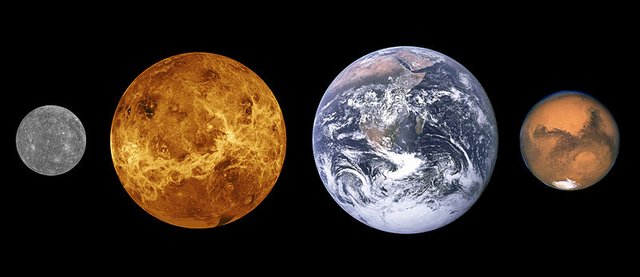
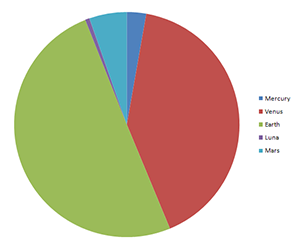
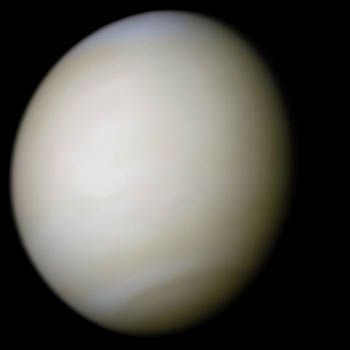
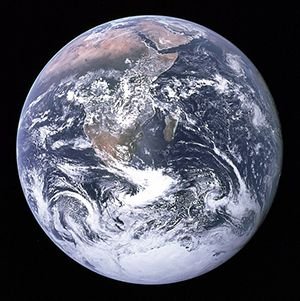
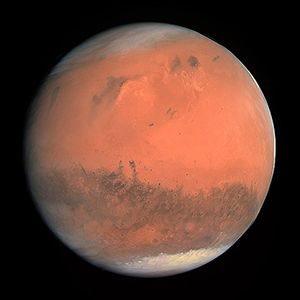
Thanks for this interesting read @agbona!
Correct, and the Earth's magnetic field is the reason the planet has an atmosphere. (Well, the reason it hasn't lost its atmoshere to be more precise). What we don't know for sure yet is what generates the Earth's magnetic field, however we do suppose that it's caused by inductive currents flowing from the core towards the mantle.
I just enjoyed your post so much!
Keep up the good work!
Absolutely, you're spot on the analysis!
Am glad you find this post interesting
But will the growing Sun not affect the Earth's orbit. Because as the Sun will get bigger and absorb other planets and go through a lot of changes, the speed at which the Earth needs to move to complete a rotation gets bigger, otherwise the orbit will decay.
I don't know for sure how, I will run a simulation later if you are also interested.
I believe it will
A simulation? I am very much interested...how can I go about it?
1729 Degrees Celsius, not bad :D
Well, at least the orbit stays the same with the additional mass of Mercury and Venus. Negligible!
Though I am sure that some forces will change and the orbits will decay.
"According to a 2008 model, Earth's orbit is shrinking due to tidal forces (and, eventually, drag from the lower chromosphere), so that it will be engulfed by the Sun near the tip of the red giant branch phase".
So yet, it will actually be engulfed in that phase, and Mars might also suffer a similar fate.
So there is a high possibility of the Earth getting engulfed by the Sun, as well as Mars? This is just amazing
So in the distant future, humanity will be forced to vacate our solar system in a bid to survive, or be faced with certain extinction?
You received a 60.0% upvote since you are a member of geopolis and wrote in the category of "geology".
To read more about us and what we do, click here.
https://steemit.com/geopolis/@geopolis/geopolis-the-community-for-global-sciences-update-4
Amazing!
Many thanks
Terrestrial planets! This is my first time hearing it.
Nice input here sire.
Wow, am glad you've learnt something new from this post.
Yes. Thanks for helping me learn.
🙌
I wish we can replicate the Sun's nuclear fusion and harness as much energy as we can. Beautful post.
Mind boggling idea, but do we possess the capacity to execute?
The energy involved in the process will be enromous
It is still a work in progress.
In the end, we all die! Even the sun is not left out.
You're absoluetly right on that one
Wow! Never knew that the planet mercury is named after the fast-footed Roman messenger god.
Here's an unrelated question bro:
What of the liquid metal "mercury", is it also named after the same god?
Well, Mercury's symbol Hg comes from its Greek name, hydrargyrum, which means "liquid silver" — to reflect its shiny surface. The element is also known as Quicksilver for its mobility.
All I know is that it is named after the fastest-moving planet in the solar system, am not sure if it was named after the god.
Really?
Wao...actually reading this for the first time "demise of terrestrial planet"
What then becomes of humans?? I guess we all die
Well written bro... Thumbs up
Even if Elon Musk succeeds in enabling man to colonize Mars, we are still doomed because as I mentioned in the post, the Sun will run out of its hydrogen and will won't be able to produce energy. This will eventually lead to its death, and a series of events will take place. Events that will lead to the death of our solar system.
I did a post about it, you can find it here.
A well written post. I must give an applause.. Good job sir
Mars could have been another alternative for a soul survivor but that lack of sun majorly pisses everything off if i must say.. The only option is to embrace the earth because i don't see any relocation to mars anytime soon.. Someone has said it., mars or earth we are still all going to die. (lol)
You are absolutely right in your analysis, but we relocating to Mars will buy humanity some time, enough to figure out a way to evacuate our solar system in search of a habitable planet in a new solar system to colonize.
I look forward to drinking to that(laughs). Thanks bro
🥂